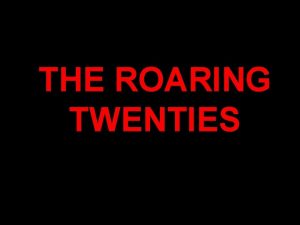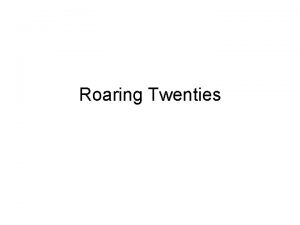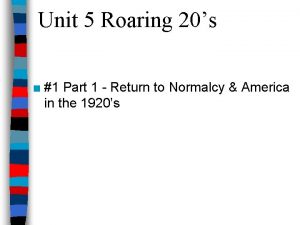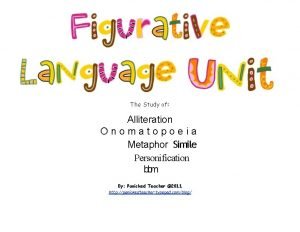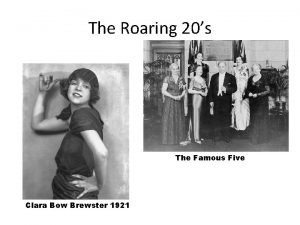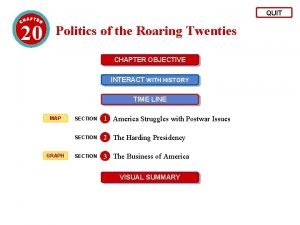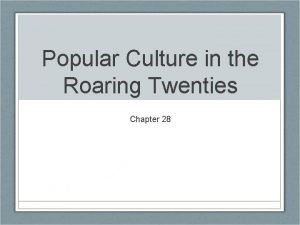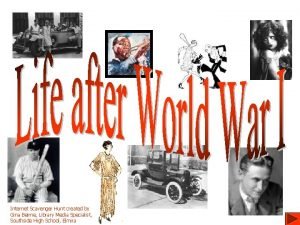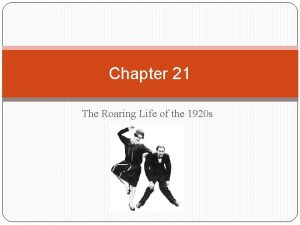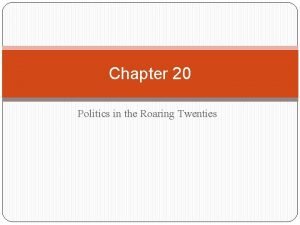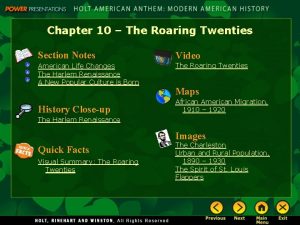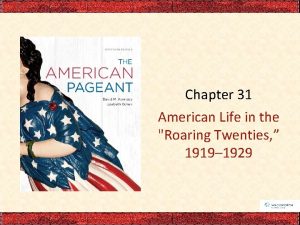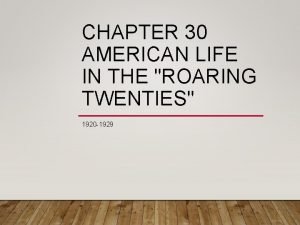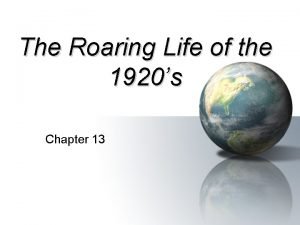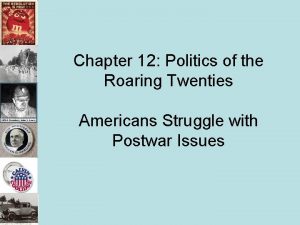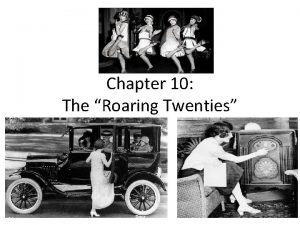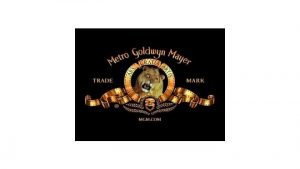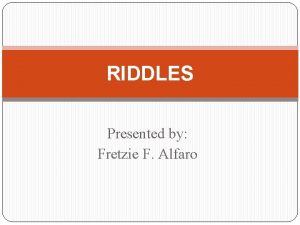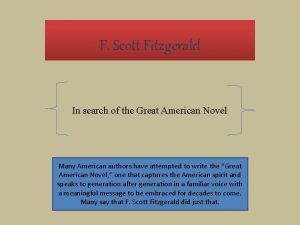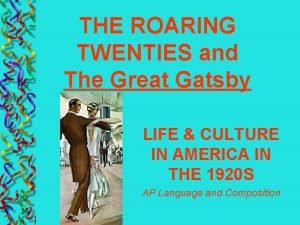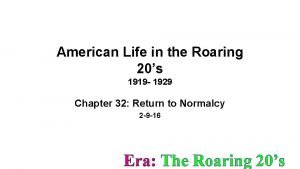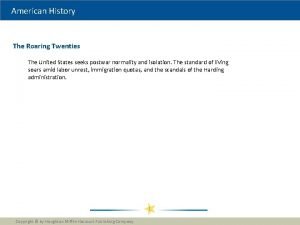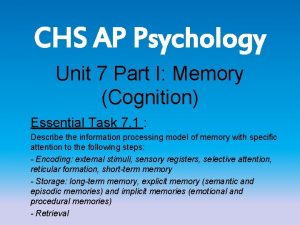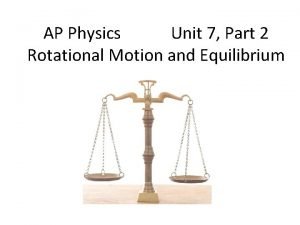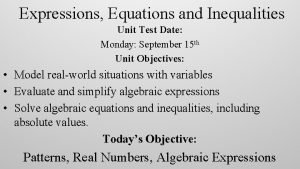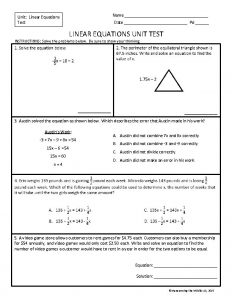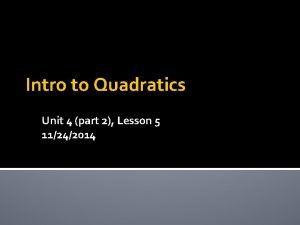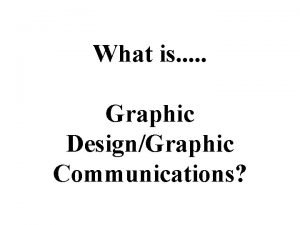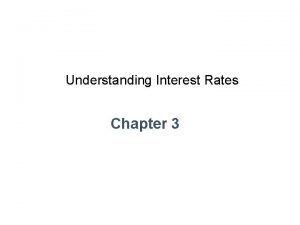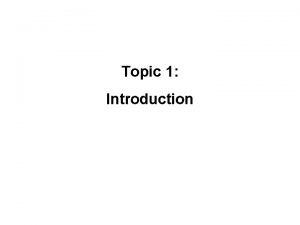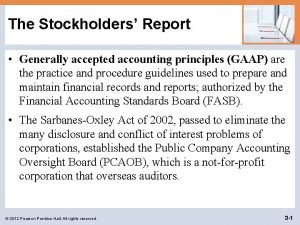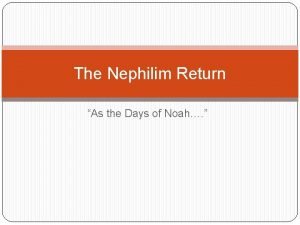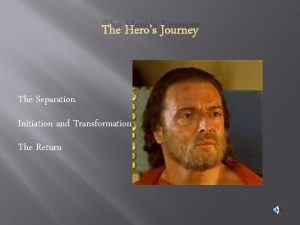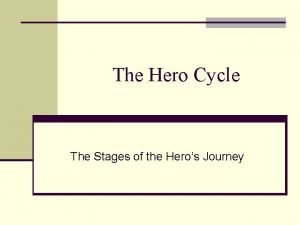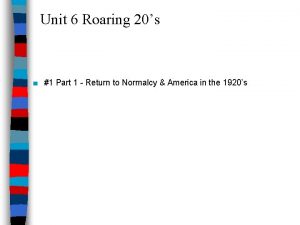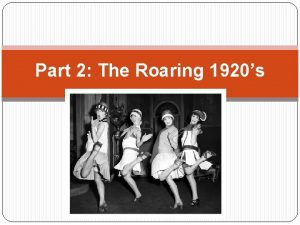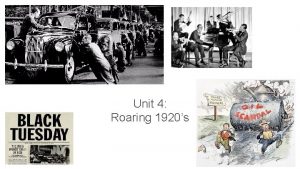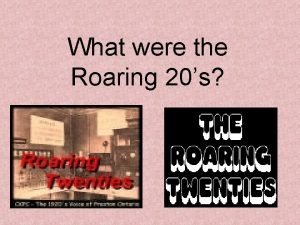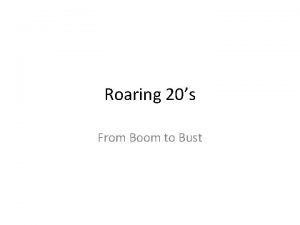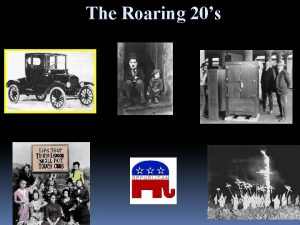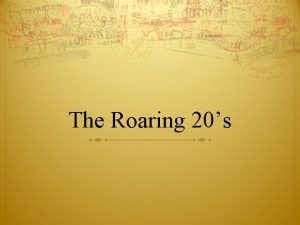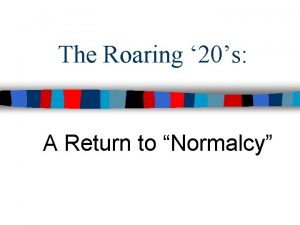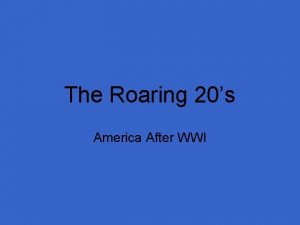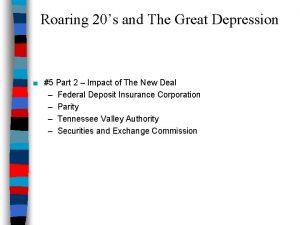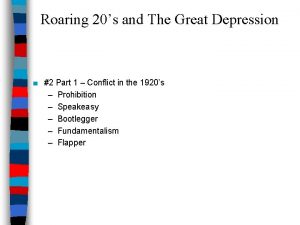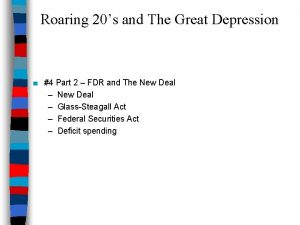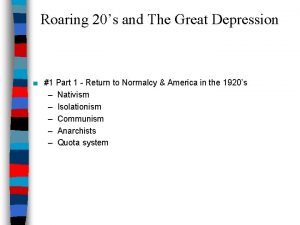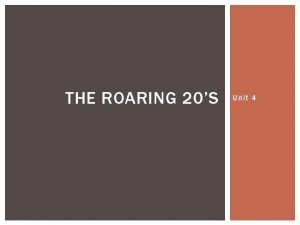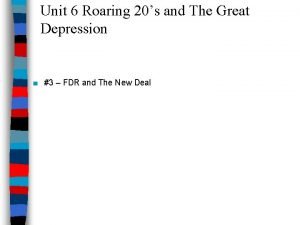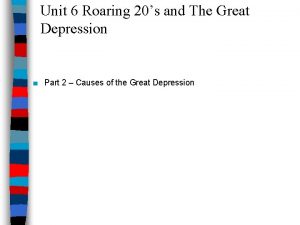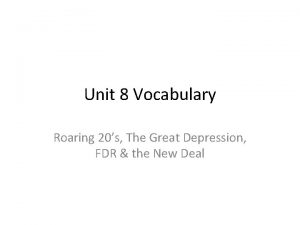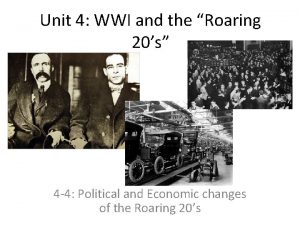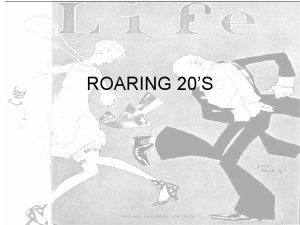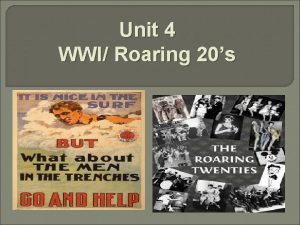Unit 6 Roaring 20s 1 Part 1 Return


































































- Slides: 66

Unit 6 Roaring 20’s ■ #1 Part 1 - Return to Normalcy & America in the 1920’s

■ Essential Question: –How did the end of World War I change America in the 1920 s? ■ Warm-Up Question: Warm-Up Question –How was America changed by World War I? • Socially? • Economically? • Politically?

The Roaring Twenties ■ Participation in WWI transformed the United States in the 1920 s: –The USA was the richest & most developed country in the world –Mass production, high wages, new consumer goods & forms of entertainment labeled the decade the “Roaring Twenties”

“A Return to Normalcy” ■ In 1920, Americans elected Republican Warren Harding who promised a “return to normalcy” “America’s present need is not heroics, but healing; not nostrums, but normalcy; not revolution, but restoration…” —President Warren Harding, 1920 What would a “return to normalcy” mean for America after WWI?

What does this image reveal about America in the 1920 s?

Foreign Policy ■ In the 1920 s, American foreign policy “returned to normal” by embracing isolationism: –The U. S. rejected the Treaty of Versailles & never joined the League of Nations –Many citizens felt the U. S. was “duped” into joining WWI & became committed to neutrality

What does this image & quote reveal about America in the 1920 s? “The chief business of the American people is business. ” —President Calvin Coolidge, 1925

Pro-Business Policies ■ In the 1920 s, three Republican presidents were elected (Harding, Coolidge, & Hoover) who helped America “return to normalcy” by adopting pro-business policies: –Kept taxes low so Americans could spend their wages –Kept gov’t interference in business to a minimum to allow private enterprise to flourish

Pro-Business Policies ■ Pro-business policies meant no new progressive reforms: –Americans felt confident that reforms had limited the influence of monopolies, cleaned up cities, & regulated the economy –As workers wages rose & their hours declined, Americans were happy to spend their money

What do these images reveal about America in the 1920 s?

The “Roaring Twenties” ■ Pro-business policies & mass production techniques developed during WWI led to an industrial revolution in consumer goods: –Industrial growth led to high wages for workers & cheap products for Americans to buy –The appetite for consumer goods & availability of cheap credit led to a decade of spending known as the “Roaring Twenties”

America entered an industrial revolution making consumer goods like cars & appliances Henry Ford’s mass production techniques made automobiles affordable for many Americans

Consumer Appliances

Entertainment

What do these images reveal about America in the 1920 s?

Urbanization By 1920, more people lived in cities than in rural areas due to the industrial revolution, mass immigration, & jobs during WWI

Urbanization ■ The dominance of urban America divided society: –Urban society was characterized by diversity, consumerism, freedom, & entertainment –Rural society was characterized by religious fundamentalism, nativism, & tradition ■ Throughout the 1920 s, the values of these 2 societies clashed

America in the 1920 s: Consumerism

Consumerism ■ The 1920 s saw a burst of personal prosperity & consumer spending –Mass production led to a huge number of new products: Cars, electric appliances, new fashions –Advertising boomed to convince people to spend their money –Companies offered ways for consumers to buy on credit through monthly installment plans

Consumer Goods, Advertising, & Credit

Red Scare

The Red Scare ■ 1919 – 1920 ■ Fear of socialist revolution and political radicalism ■ Fear of Southern and Eastern European Immigrants

Palmer Raids & Anarchy ■ Anarchy – Self – governed societies with voluntary cooperation – Violent overthrow of the government ■ Palmer Raids – Series of police raids from 1919 – 1920 – Capture, arrest and deport radical anarchists and socialists

Sacco and Vanzetti 1920 ■ Italian anarchists who were accused of murdering a guard and paymaster during armed robbery of Slater and Morrill Shoe Company ■ Laughable trail process, were widely thought to be innocent ■ Were executed via electric chair on august 23, 1927

National Origins Act 1924 ■ Result of the Red Scare ■ Set limit on number of immigrants who could be admitted to the US every year from each country – Only 2% of population already living in the US from that country

America in the 1920 s: Harlem Renaissance

Harlem Renaissance ■ The Great Migration during WWI led to a concentration of African Americans in northern cities ■ The Harlem Renaissance was the flourishing of black culture: –Jazz blended African & European musical traditions into a distinctly “American” style of music –Louis Armstrong & Duke Ellington were popular jazz musicians

New Negro Movement ■ Founded by Hubert Harrison ■ Called for political equality and an end to lynching and segregation ■ Shed old image of servility and inferiority, achieve new image of pride and dignity!

The “Jazz Age”

Louis Armstrong

Harlem Renaissance –The most popular author was Langston Hughes, who wrote poems & novels about black pride ■ Harlem represented the “New Negro”: the idea that African Americans should freely express themselves, embrace their culture, & strive for racial equality


Lynching

Lynching ■ Lynching is usually associated in the United States with punishment directed towards blacks, who made up a highly disproportionate number of victims ■ Groups such as the KU KLUX KLAN and the Knights of the White Camelia attracted white Southerners who had been left destitute by the war. These groups promoted this form of domestic terrorism (sometimes indirectly) as a means of regaining white supremacy. ■ Often, the victim of a lynching would be dragged from his or her home; not infrequently, a lynch mob would drag a victim from a jail cell where supposedly he or she was to be awaiting a fair trial ■ The spectators often included "respectable" men and women, and children were often brought to lynchings. A lynching victim might be shot, stabbed, beaten, or hanged; if he was not hanged to death, his body would often be hung up for display. ■ Often, all that a black man had to do to be accused of rape was to speak to a white woman or ask her out. Lynchers justified their actions by saying that they needed to protect women from dangerous men.

Lynching ■ ■ ■ NAACP was at the forefront of the Anti – Lynching campaign Kept track of Lynching statistics all throughout the South Activists such as Booker T. Washington and W. E. B. Du Bois actively campaigned against lynching This flag flew outside of the NAACP office each time a man was lynched until WWII when they were forced to take it down due to political pressure during the War. Most Notably incidents – – Wyatt Outlaw – Graham, N. C. 1870 Jesse Washington - Waco, Texas 1916 Emmett Till – Money, Mississippi 1955 Thomas Shipp and Abraham Smith, 1930 – Marion, Indiana • (Strange Fruit Song)

America in the 1920 s: The Changing Role of Women

Changing Role of Women ■ Women’s roles changed in the 1920 s –In 1920, the 19 th Amendment granting women the right to vote (But, many women did not vote) –New fashion trends, voting rights, & more leisure time led to an increased sense of freedom –Advertisers emphasized women’s sexuality & appearance


Changing Role of Women ■ Many young, unmarried women embraced their independence & sexuality as “flappers”: –Fashions like shorter hemlines, “bobbed” hair, & hats –Smoked cigarettes, drank alcohol, danced at clubs, used makeup –Many had sex outside of marriage & used cars to “park” with boys ■ These behaviors were shocking to traditional-minded women

Flapper Fashion

America in the 1920 s: Literature

Literature ■ The 1920 s produced some of America’s most important literature –Authors F. Scott Fitzgerald & Sinclair Lewis were critical of 1920 s consumerism & conformity –Some authors became part of a the “Lost Generation” who rejected war & were very critical of American society

Ernest Hemingway ■ Leader of the “Lost Generation” ■ a strong influence on 20 th-century fiction, many works are classics of American Literature. ■ Served in WWI, influenced his writing. ■ The Sun Also Rises (1926) ■ A Farewell to Arms (1929) ■ For Whom the Bell Tolls (1940)

Significant Authors of the 1920 s Ernest F. Scott T. S. Hemingway Fitzgerald Eliot

America in the 1920 s: Sports Mania

Sports Mania ■ New forms of entertainment emerged in the 1920 s as Americans gained more leisure time & personal income –Baseball, boxing, & football were popular sports –Radio broadcasts brought sporting events to national audiences –Sports gave Americans a new generation of heroes

Sports Heroes of the 1920 s Baseball segregated; Babe Ruthwas of the New York Satchel Paige & Josh Gibson Yankees was the biggest were Negro League heroes sports hero of the 1920 s

The Big Bambino ■ https: //www. youtube. com/watch? v =Hk. EX 0 eb 2 e. Bo

Sports Heroes of the 1920 s Heavyweight boxer Jack Dempsey was so popular, his prize fights set financial & attendance records throughout the 1920 s

Sports Heroes of the 1920 s Other sports heroes of the 1920 s include: Red Grange, Gertrude Ederle, Bobby Jones

America in the 1920 s: Movies & Radio

Popularity of Movies & Radio ■ Movies & radios became widely popular in the 1920 s: –Over 500 stations connected the nation by broadcasting music, sports, as well as news, religious, comedic, & dramatic programming –“Talking” movies helped grow Hollywood & celebrity movie stars –By 1929, over 100 million people went to movies each week

Radio in the 1920 s

Music of the 1920 s Tin Pan Alley produced Irving Berlin was the 90% of the popular most popular of the music in the 1920 s, ragtime composers focusing on ragtime, of the 1920 s dance music, & jazz

The Charleston … Try it! ■ https: //www. youtube. com/watch? v =p. Up. Ac. PAip. DA

Movies in the 1920 s “The Jazz Singer” was the first “talking” picture

Buster Keaton

Silent Film Stunts

More Buster Keaton!

Harold Llyod

America in the 1920 s: Improved Transportation

Improved Transportation ■ Automobiles transformed America: –Henry Ford’s assembly line made cars affordable; By 1929, 1 of 5 Americans owned a car –Car manufacturing became the biggest industry in the nation & stimulated the U. S. economy –New roads, gas stations, & shopping centers were built –Cars gave people freedom & became a symbol of status

The Automobile

The Automobile

Improved Transportation ■ Airplanes captured the attention of Americans in the 1920 s –In 1927, Charles Lindbergh made the 1 st trans. Atlantic solo flight, becoming the biggest celebrity of the 1920 s

 The roaring twenties were characterized by -
The roaring twenties were characterized by - Roaring 20s vocabulary
Roaring 20s vocabulary Demobilization and adjustment to peace 1920
Demobilization and adjustment to peace 1920 20s decade fashion
20s decade fashion Reaction of grignard reagent with acid chloride
Reaction of grignard reagent with acid chloride Sports mania in the 1920s
Sports mania in the 1920s Clock alliteration
Clock alliteration Roaring twenties acrostic poem
Roaring twenties acrostic poem Chapter 20 politics of the roaring twenties answer key
Chapter 20 politics of the roaring twenties answer key Chapter 28 popular culture in the roaring twenties
Chapter 28 popular culture in the roaring twenties Roaring twenties scavenger hunt answers
Roaring twenties scavenger hunt answers Steamboat willie apush
Steamboat willie apush Chapter 20 politics of the roaring twenties
Chapter 20 politics of the roaring twenties Chapter 10 the roaring twenties answer key
Chapter 10 the roaring twenties answer key Romeo and juliet act 4 scene 1 quotes
Romeo and juliet act 4 scene 1 quotes Chapter 31 american life in the roaring twenties
Chapter 31 american life in the roaring twenties Chapter 30 american life in the roaring twenties
Chapter 30 american life in the roaring twenties Chapter 13 the roaring life of the 1920s
Chapter 13 the roaring life of the 1920s Chapter 12 politics of the roaring twenties
Chapter 12 politics of the roaring twenties Chapter 10 the roaring twenties
Chapter 10 the roaring twenties The roaring twenties canada
The roaring twenties canada Hindi pari hindi hari nagdadamit
Hindi pari hindi hari nagdadamit The roaring 20’s / jazz age
The roaring 20’s / jazz age Roaring twenties great gatsby
Roaring twenties great gatsby Chapter 20 politics of the roaring twenties
Chapter 20 politics of the roaring twenties Roaring rockets powerpoint
Roaring rockets powerpoint Roaring flame bunsen burner
Roaring flame bunsen burner Roaring twenties acrostic poem
Roaring twenties acrostic poem The roaring twenties lesson 3 changing ways of life
The roaring twenties lesson 3 changing ways of life Unit 7 lesson 2 parameters and return investigate
Unit 7 lesson 2 parameters and return investigate Market risk examples
Market risk examples Return to unit
Return to unit Unit 6 review questions
Unit 6 review questions Part whole model subtraction
Part whole model subtraction Unit ratio definition
Unit ratio definition Brainpop ratios
Brainpop ratios Technical description
Technical description Bar
Bar The part of a shadow surrounding the darkest part
The part of a shadow surrounding the darkest part Minitab adalah
Minitab adalah Unit 7 ap psych
Unit 7 ap psych Rotational inertia and torque
Rotational inertia and torque Definition of a kite in geometry
Definition of a kite in geometry 1.18 unit test solving inequalities - part 1
1.18 unit test solving inequalities - part 1 Expressions equations and inequalities unit test
Expressions equations and inequalities unit test External parts of the computer
External parts of the computer Representativeness heuristic
Representativeness heuristic Linear systems unit test part 1
Linear systems unit test part 1 Gse algebra 1 unit 1 test
Gse algebra 1 unit 1 test Unit 6 part 2
Unit 6 part 2 Unit 7 progress check: mcq part c
Unit 7 progress check: mcq part c Algebra 2 quadratics review
Algebra 2 quadratics review Unit 6 part 1
Unit 6 part 1 How to calculate annualized return
How to calculate annualized return Winman software download
Winman software download Graphic communications definition
Graphic communications definition Return outwards in profit and loss account
Return outwards in profit and loss account Return valve function
Return valve function Lesson 3 parameters and return practice 8
Lesson 3 parameters and return practice 8 Holding-period return
Holding-period return Total anomalous pulmonary venous return
Total anomalous pulmonary venous return Time weighted return
Time weighted return P&l format
P&l format Return on common stockholders' equity ratio formula
Return on common stockholders' equity ratio formula Will the nephilim return
Will the nephilim return When does odysseus cross the threshold
When does odysseus cross the threshold Crossing of the return threshold
Crossing of the return threshold

